Introduction
When it comes to pasta salad, it’s easy to think of it as a no-fail dish. After all, it’s just pasta, veggies, and dressing—how hard can it be? Yet, many home cooks find their creations falling flat, with issues like soggy pasta, bland flavors, or an unappealing mix of ingredients. This guide unravels the top five mistakes to avoid pasta salad woes and provides you with simple fixes to create a flawless, crowd-pleasing dish every time. From choosing the perfect pasta shape to balancing the flavors in the dressing, we’ll walk you through each essential step. Let’s dive into part 1 to get started!
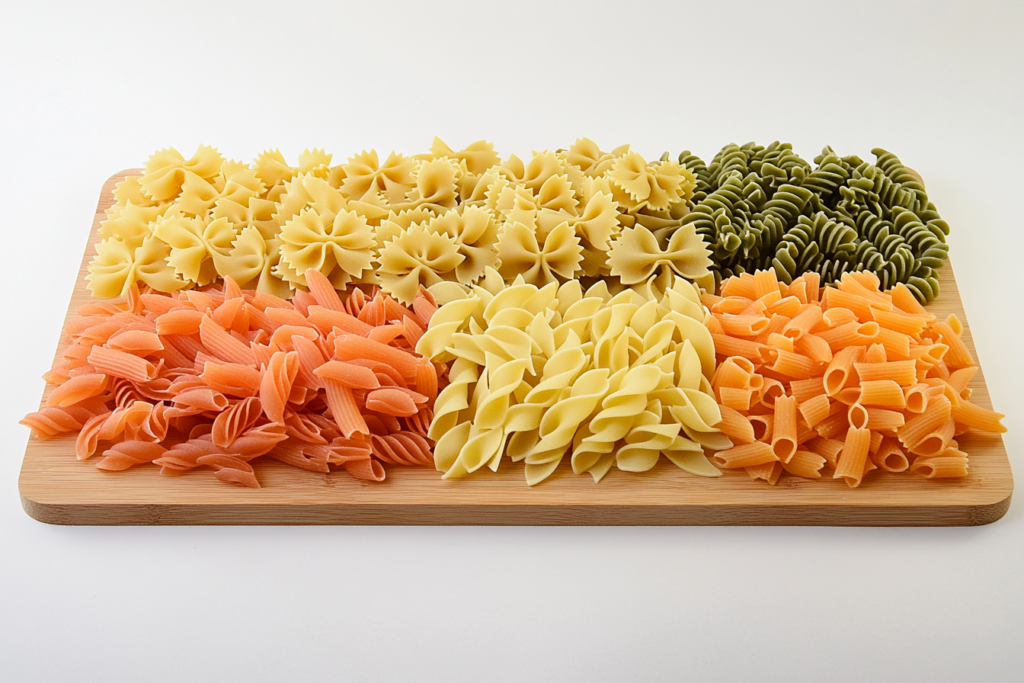
Choosing the Right Pasta
Why Pasta Shape Matters in Avoiding Common Pasta Salad Mistakes
When crafting the perfect pasta salad, choosing the right pasta shape is essential for avoiding common pasta salad mistakes. Believe it or not, many pasta salad errors happen before the noodles even hit the pot! Pasta shape isn’t just about appearance—it directly impacts how well the dressing adheres and how flavors meld together with the mix-ins.
Varieties like penne, rotini, and farfalle are excellent choices for pasta salad preparation because their ridges and twists trap dressing and ingredients, ensuring every bite bursts with flavor. These shapes also hold up well during tossing and mixing, maintaining the salad’s integrity and appeal.
Conversely, smooth and slippery pastas, such as spaghetti or linguine, often let the dressing slide off, leaving a bland and unevenly coated dish. Avoid these pasta salad mistakes by selecting textured pasta shapes that enhance both the flavor and overall presentation of your salad. This seemingly small decision can be the difference between a forgettable dish and a truly standout pasta salad.
Recommended Pasta Types for a Perfect Pasta Salad to Avoid Common Pasta Salad Mistakes
To avoid common pasta salad mistakes, start with a pasta that holds its shape and texture after cooking. Short pasta varieties such as fusilli, bowtie (farfalle), or cavatappi work particularly well. These shapes not only look visually appealing but also make it easy to scoop up every component of the salad.
For added color and pizzazz, try tri-color rotini, which requires no extra effort but creates a visually stunning dish. If you’re health-conscious, whole-grain pasta offers a nuttier flavor and added fiber, making your pasta salad both nutritious and delicious. Gluten-free pasta options, made from chickpea or rice flour, are also excellent choices, provided they’re cooked properly to maintain their integrity.
Choosing the right pasta shape and type is the foundation of a truly standout pasta salad, ensuring that every other element—dressing, vegetables, and proteins—works in perfect harmony.
Choosing the Right Pasta
The Importance of Pasta Shape in Avoiding Common Pasta Salad Mistakes
Crafting the perfect pasta salad is more than just combining ingredients—it’s about achieving the right balance of textures and flavors. One of the most common pasta salad mistakes is neglecting to consider pasta shape. Believe it or not, the type of pasta you choose can determine how well your dressing and mix-ins cling to the noodles, which makes it a vital step in avoiding pasta salad errors.
Curved or ridged shapes like rotini, farfalle, and penne are fantastic choices because their grooves trap the dressing, ensuring every bite is as flavorful as the last. These shapes also work beautifully with vegetables and proteins, enhancing the overall harmony of the salad. Conversely, smooth or flat pasta, such as spaghetti or linguine, often lets the dressing slide off, leaving you with a bland, disappointing dish. To prevent this pasta salad disaster, always opt for textured or twisted shapes that elevate the flavor experience.
Moreover, size plays a significant role. Smaller pasta shapes like fusilli blend seamlessly with other ingredients, ensuring a cohesive mix that’s both easy to eat and visually appealing. By paying attention to the shape and size of your pasta, you’ll avoid common pasta salad mistakes and create a dish that truly delights every guest.
Recommended Pasta Types for the Best Pasta Salad
To prevent pasta salad mistakes, select pasta that retains its shape and texture after cooking. Fusilli, cavatappi, and orecchiette are ideal options for a perfect pasta salad. Their ridged surfaces and compact sizes allow the dressing to cling effortlessly, delivering flavor in every bite. These shapes also stand up well during mixing, ensuring your salad stays intact.
For a creative and visually appealing twist, consider farfalle, or bowtie pasta. Its unique design not only adds whimsy to your dish but also provides the same functional benefits as other textured shapes. Another excellent choice is tri-color rotini, which brings vibrant hues of green, orange, and white to your salad without requiring extra effort.
For health-conscious cooks, whole wheat pasta offers a nutty flavor and added fiber, making it a nutritious base for salads with vinaigrettes or zesty dressings. Gluten-free pasta made from rice, lentils, or chickpeas can also be used, but be sure to cook it carefully to avoid a mushy texture.
By paying attention to the type and shape of your pasta, you can avoid common pasta salad errors and lay the foundation for a dish that’s both delicious and memorable.
Cooking Pasta Properly to Avoid Common Pasta Salad Mistakes
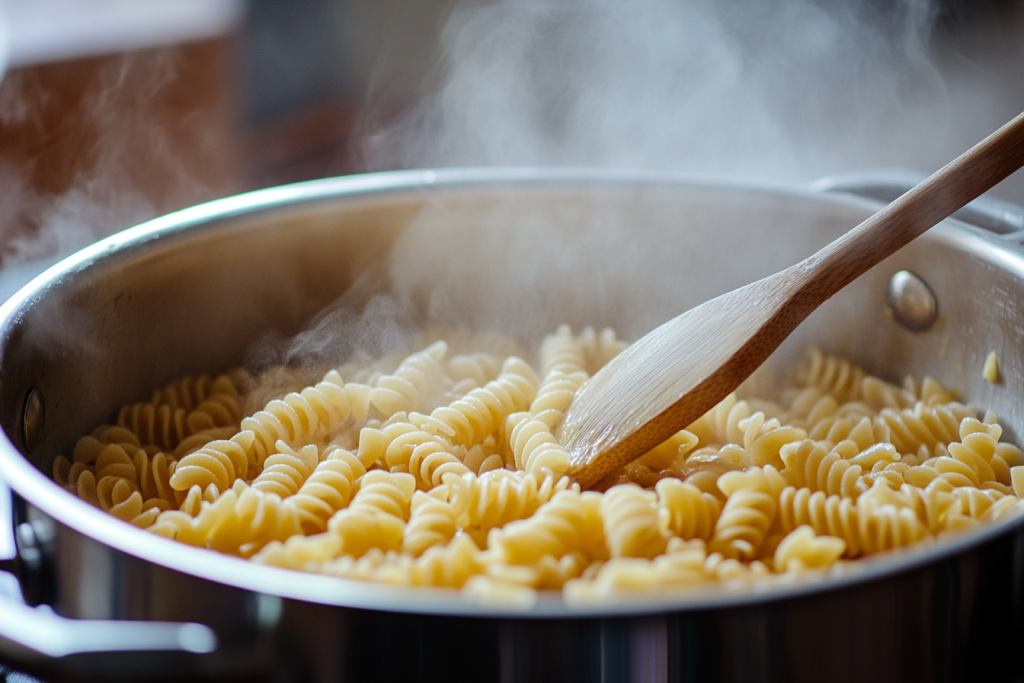
How to Avoid Overcooking or Undercooking Pasta for the Perfect Pasta Salad
One of the most frequent pasta salad mistakes is cooking the pasta incorrectly. Overcooked pasta turns mushy and breaks apart when tossed with dressing and mix-ins, while undercooked pasta feels too firm, creating an unpleasant texture clash with softer ingredients like tomatoes or mozzarella.
To avoid these common pasta salad errors, aim for an al dente texture. This means the pasta should be firm to the bite but not hard. Follow the cooking time on the package as a general guide, but always taste-test as you go. Keep in mind that the pasta will continue to soften slightly as it absorbs the dressing, so don’t overcook it.
A helpful tip is to stir the pasta frequently while it cooks, especially when working with smaller shapes like orzo or ditalini, to prevent sticking. Perfectly cooked pasta is the foundation of any perfect pasta salad, so getting this step right is essential.
The Importance of Salting Pasta Water in Pasta Salad Preparation
Salting pasta water is a simple yet crucial step that can elevate your pasta salad preparation and prevent bland results. Salt infuses the pasta with a subtle flavor as it cooks, creating a base layer of seasoning that complements the dressing and other ingredients. Without this step, even the best dressing won’t save a dull, flavorless salad.
To get it right, add about one to two tablespoons of salt for every gallon of water. The water should taste like the sea—salty but not overly so. However, avoid adding oil to the water. While many believe this prevents sticking, it actually coats the pasta and repels the dressing later, leading to uneven flavor distribution.
Once the pasta is cooked, drain it well but avoid rinsing (unless you’re making a cold pasta salad, where rinsing helps cool the pasta faster). Leaving a slight starchiness on the pasta helps the dressing adhere, ensuring a dish bursting with flavor. By mastering this step, you’ll avoid pasta salad mistakes and create a delicious, well-seasoned base for your salad.
Cooling the Pasta Properly
Rinsing vs. Not Rinsing Pasta for Salad
Ah, the great debate—should you rinse pasta after cooking it for a salad? The answer depends on the type of pasta salad you’re making. Rinsing pasta, especially for a cold pasta salad, serves a dual purpose: it halts the cooking process and removes excess starch. This keeps the pasta from clumping together and becoming gummy, which is crucial when it’s going to be served chilled.
However, if the pasta is going to be tossed immediately with a hot or room-temperature dressing, rinsing might not be the best option. That extra starch on unrinsed pasta helps the dressing adhere better, locking in flavor with every bite. The key is to match your technique to your salad. When in doubt, give the pasta a quick rinse under cold water if it’s meant to cool completely.
While rinsing works well for cooling, overdoing it can strip the pasta of its seasoning. Be gentle and use just enough cold water to stop the cooking process.
Techniques for Cooling Pasta Efficiently
If you choose not to rinse but still need to cool your pasta quickly, there are alternative methods that work beautifully. Spread the cooked pasta onto a large baking sheet in a single layer, allowing it to cool evenly. Toss it lightly with a splash of olive oil to prevent sticking.
For an even faster approach, pop the baking sheet into the refrigerator for a few minutes. Another trick? Use an ice bath. Place the colander with drained pasta into a bowl of ice water. This ensures rapid cooling without affecting the pasta’s texture too much. Once cooled, pat the pasta dry with a clean kitchen towel or paper towel to avoid adding excess water to your salad.
Dressing the Pasta Salad to Avoid Common Pasta Salad Mistakes
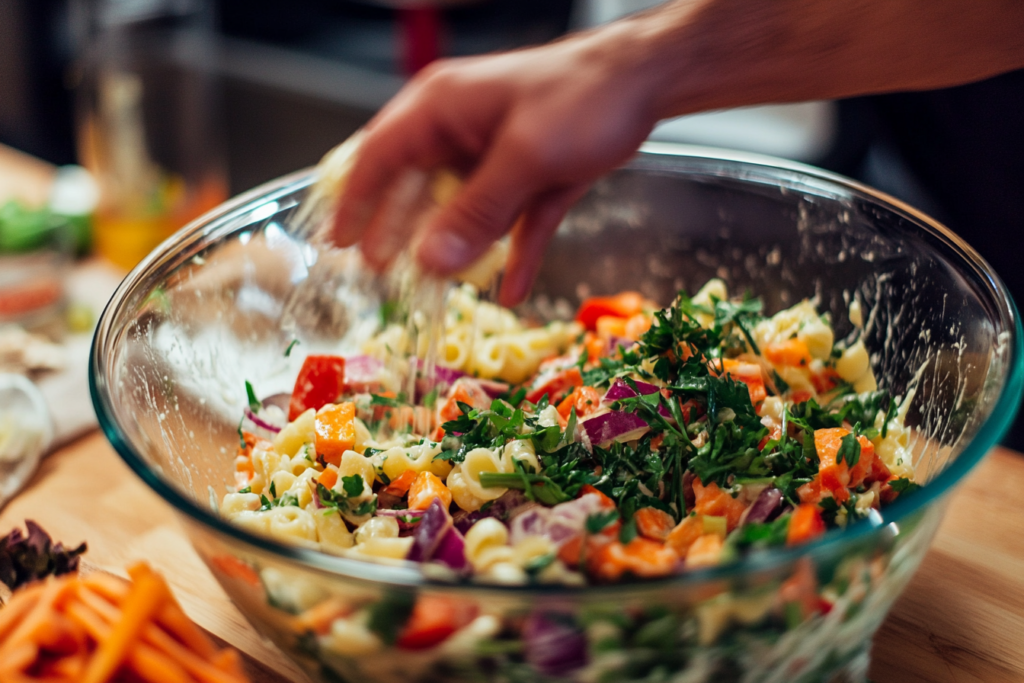
The Perfect Timing for Adding Dressing to Prevent Pasta Salad Errors
Timing is everything when it comes to pasta salad preparation, and adding the dressing at the wrong moment is one of the most common pasta salad mistakes. If you add it too early, the pasta can absorb all the liquid, leaving your salad dry and lacking flavor. On the other hand, adding the dressing too late prevents the ingredients from melding together, resulting in a disjointed dish.
For warm pasta salads, toss the dressing while the pasta is still warm. This helps the pasta absorb the flavors more effectively, creating a cohesive and flavorful dish. For cold pasta salad, wait until the pasta has completely cooled to maintain the right texture. A smart trick is to divide the dressing into two portions: toss half with the warm pasta to coat it lightly and save the other half to mix in just before serving. This method ensures your pasta salad remains fresh, vibrant, and well-balanced.
Balancing Flavors in the Dressing for the Perfect Pasta Salad
A well-balanced dressing can elevate your pasta salad from ordinary to extraordinary. The key is to harmonize flavors—acid, salt, fat, and sweetness. Start with a base like olive oil, yogurt, or mayonnaise, and then layer in acidity using vinegar or lemon juice. Season with salt to enhance taste and add a touch of sweetness, such as honey or sugar, to round out the flavors.
To enrich the dressing further, incorporate fresh herbs like basil or parsley and spices such as garlic powder, paprika, or crushed red pepper. Taste as you go, tweaking the dressing until it achieves the perfect balance. Remember, the dressing is the heart of your pasta salad, but too much can overpower the dish. A light coating ensures the pasta and mix-ins can shine while maintaining a cohesive and delicious flavor profile. Mastering the art of balancing the dressing will help you avoid pasta salad mistakes and create a dish that everyone will love.
Serving and Storing Pasta Salad
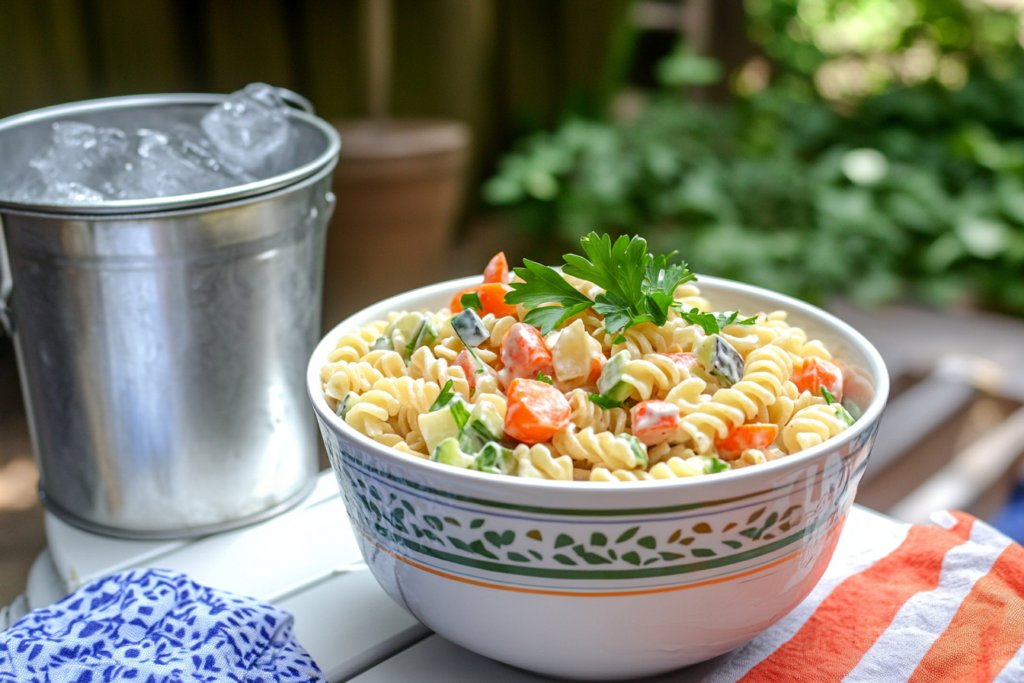
Ideal Serving Temperatures to Avoid Common Pasta Salad Mistakes
The temperature at which you serve pasta salad plays a crucial role in its overall taste and texture. For cold pasta salad, the key is serving it slightly chilled—but not too cold. If the salad is served ice-cold, the flavors in the dressing can become muted, and the pasta’s texture may feel stiff or unappealing. To sidestep this pasta salad error, remove it from the refrigerator 15–20 minutes before serving. This allows the salad to come to an optimal temperature where the flavors can shine.
For warm pasta salads, timing is essential. Serve them immediately after mixing in the dressing to retain the warmth and ensure the flavors meld seamlessly. If reheating is necessary, stir in a splash of olive oil or a bit of fresh dressing to prevent the pasta from drying out. This small adjustment keeps your pasta salad preparation fresh and flavorful every time.
Tips for Storing Pasta Salad to Maintain Freshness
Proper storage is vital for keeping your pasta salad fresh and enjoyable, especially if you plan to prepare it in advance. Store the salad in an airtight container to retain moisture and prevent it from absorbing other fridge odors. If you’re making the salad ahead of time, one of the most effective strategies to avoid common pasta salad mistakes is to store the dressing separately. This prevents the pasta from soaking up too much liquid and becoming soggy.
Pasta salad can be stored safely in the refrigerator for up to three days. When reheating leftovers, give the salad a quick toss and refresh it with a small amount of dressing or a squeeze of lemon juice. Avoid letting pasta salad sit out at room temperature for extended periods to prevent spoilage. For picnics or potlucks, keep the dish chilled by placing the container in a larger bowl filled with ice. These simple tips ensure your pasta salad storage maintains its texture and flavor, no matter when it’s served.
Frequently Asked Questions (FAQs)
How Can I Prevent Dry Pasta Salad and Avoid Common Pasta Salad Mistakes?
The secret to preventing dry pasta salad and steering clear of common pasta salad mistakes lies in perfecting your timing and technique. Toss the freshly cooked pasta with a portion of the dressing while it’s still slightly warm. This allows the pasta to absorb moisture and flavor, ensuring it stays moist and flavorful as it cools.
Just before serving, refresh the salad by adding the remaining dressing to revitalize its taste and texture. If the salad still seems dry, a light drizzle of olive oil or a squeeze of fresh lemon juice can work wonders to restore its creamy, appealing consistency. By mastering these simple steps, you can eliminate pasta salad errors and create a perfectly moist and delicious dish every time.
What Are the Best Pasta Shapes for a Perfect Pasta Salad?
To avoid common pasta salad mistakes, choose shapes that capture dressing and ingredients well. Rotini, fusilli, farfalle, and penne are perfect options due to their ridges and curves. These shapes trap the dressing and enhance every bite, ensuring a flavorful and cohesive salad. Long, smooth pastas like spaghetti or linguine often cause dressing to slide off, making them less ideal for pasta salads.
Should I Rinse Pasta for Cold Pasta Salad?
Yes, rinsing is a critical step for cold pasta salad. Rinsing stops the cooking process, cools the pasta quickly, and removes excess starch that can make the salad sticky. However, for warm pasta salad, avoid rinsing, as the natural starch helps the dressing adhere better, ensuring the salad is flavorful.
How Long Can Pasta Salad Be Stored in the Fridge?
Proper storage is essential to maintain the quality of your pasta salad. Store it in an airtight container in the refrigerator, where it can stay fresh for up to three days. To prevent sogginess, consider storing the dressing separately and mixing it in just before serving. This keeps your salad vibrant and crisp.
Can I Prepare Pasta Salad in Advance?
Absolutely! Preparing pasta salad a day ahead can actually improve its flavor, as the ingredients have time to meld together. To avoid any loss of texture, store the dressing separately or save a portion to mix in right before serving. This ensures your pasta salad preparation results in a dish that’s both fresh and delicious.
Conclusion
Pasta salad, when done right, is a culinary masterpiece that’s simple, versatile, and crowd-pleasing. By following these guidelines, you can sidestep common pitfalls like soggy pasta, bland dressing, or ingredient overload. From choosing the perfect pasta shape to balancing flavors and storing it correctly, every detail matters in crafting the ideal dish.
Remember, the secret lies in the harmony of ingredients and preparation. Use pasta that holds dressing well, don’t skimp on flavor in the dressing, and strike the right balance with your mix-ins. Whether you’re making a zesty Mediterranean-style salad or a classic mayo-based version, these tips will ensure your creation is not only delicious but also memorable.
So, the next time you’re tasked with whipping up pasta salad for a potluck or family dinner, rest assured you’ve got the tools to make it perfect. Say goodbye to pasta salad errors and hello to a dish that’s sure to impress!

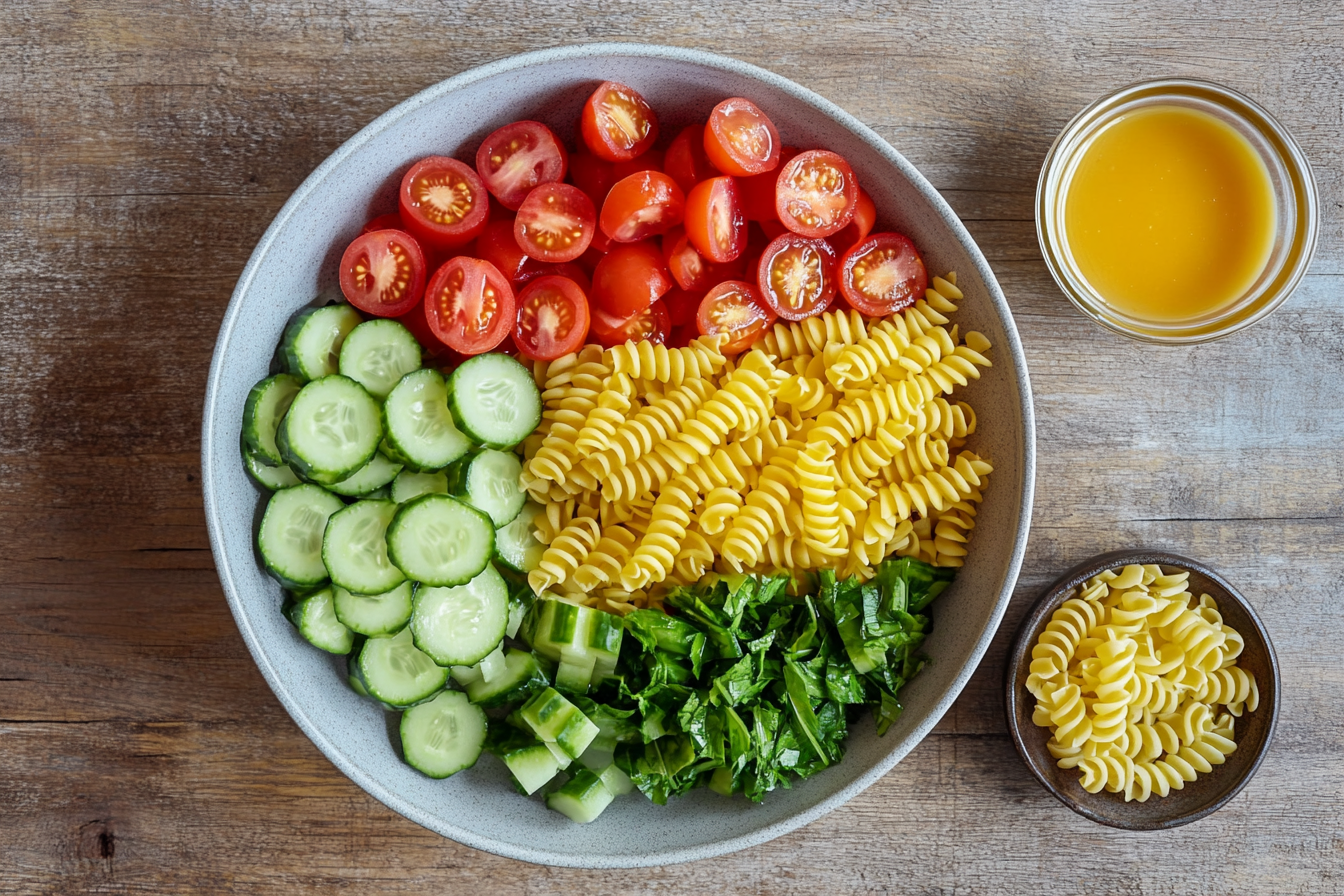
1 thought on “5 Common Mistakes to Avoid When Making the Perfect Pasta Salad”